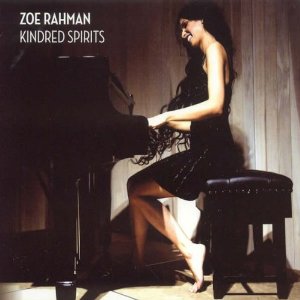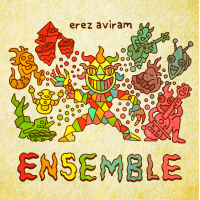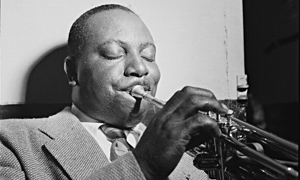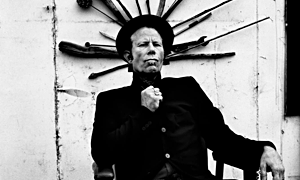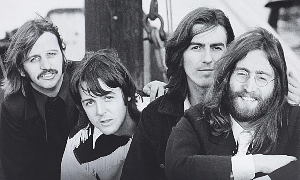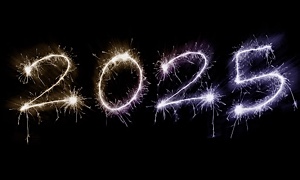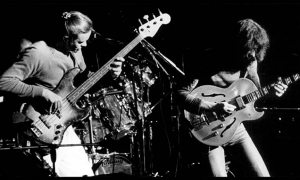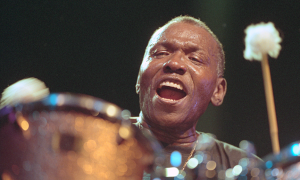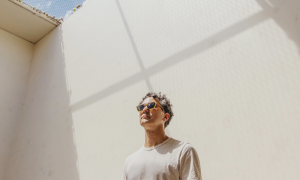Home » Jazz Articles » Book Review » Kathy Sloane: Keystone Korner - Portrait Of A Jazz Club
Kathy Sloane: Keystone Korner - Portrait Of A Jazz Club
 Keystone Korner: Portrait Of A Jazz Club
Keystone Korner: Portrait Of A Jazz ClubKathy Sloane
220 pages; audio CD
ISBN: 978-0-253-35691-8
Indiana University Press
2012
Photographer Kathy Sloane's Keystone Korner: Portrait Of A Jazz Club is a love letter: a love letter to something more than just a business, to something less than a generation. It's a love letter to a relatively short-lived community that coalesced around a jazz club in San Francisco's North Beach neighborhood: the people who worked there, the characters who frequented it, the musicians who played there. If Sloane's act of authorship is a love letter, the story that emerges is a bittersweet tragedy, driven by the well-rehearsed tension between art and commerce and set against the backdrop of San Francisco in the 1970s, a time and place that proved insufficiently mobilized by the inspired musical programming of the Keystone Korner to adequately sustain it.
First, there are the photographs, over a hundred of them in sober black and white. Sloane, in an Afterword that is candid and modest and disarming in tone, recounts her coming of age as a self-taught photographer at Keystone Korner. She also describes the challenges posed by the lighting in the tiny club for a would-be photo-chronicler, challenges that she appears to have overcome. Some belong among the greatest jazz portraits: the superb shot of pianist Muhal Richard Abrams used for the cover; a couple of portraits of reed player Rahsaan Roland Kirk on stage, in repose; a frenetic multiple exposure of pianist Cecil Taylor; just about every shot herein of tenor saxophonist Dexter Gordon (is he just particularly photogenic?). Many others have a greater documentary value, recording the visual history of the jazz life in the 1970s on stage, back stage, and in the case of drummer Art Blakey, at Sloane's East Bay apartment for a home-cooked meal with her daughter.
The book is more than a collection of photographs, however. Sloane has also compiled an oral history of the Keystone Korner lifespan from June 1972, when Todd Barkan bought it, to 1983, when he was forced to close down. Reminiscences are included from the staff, including chef Ora Harris, who had previously opened a Boston eatery for avant-garde jazz artists and whose cooking ensured that the musicians showed up on time; from the musicians, among them house rhythm section members drummer Eddie Marshall and pianist George Cables; from the habitués, with extra time extended to jazz chronicler Al Young and San Francisco poet laureate Jack Hirshman, who draws parallels between rap music and 1920s Soviet poets. Given that Sloane taught herself to be such a good photographer, we should not be so surprised at how good an oral historian she is, but the apparent ease with which the volume has been assembled and the coherence with which the chorus of voices are woven to tell a story, should not blind us the difficulty of the task. This book, on the basis of the text alone, merits a spot on the shelf alongside the classic oral jazz histories of Nat Hentoff and Studs Terkel.
Why does Keystone Korner matter? The redoubtable Orrin Keepnews, the great producer behind Riverside Records in the 1950s and 1960s, who was resident in the Bay Area during Keystone's run, and is a privileged participant in Sloane's interviews, puts it this way: "Its significance is that it reminds a lot of people—when you think about it, or when you bring it up, or when you tell the story again—that, hey, it is possible to put together some positive ingredients and have a good, working jazz club."
 Cecil Taylor
Cecil TaylorThe most salient of those "positive ingredients" was undoubtedly owner/manager Todd Barkan's (described elsewhere by Keepnews as a "boy wonder") booking. Several musicians compare the breadth of Barkan's programming to what they experienced at European festivals, and credit him with building and developing a jazz audience in the Bay Area. Barkan himself describes Keystone Korner as "a bona fide psychedelic jazz club that emerged out of the post-psychedelic era in San Francisco—right out of flower children and Haight-Ashbury," and himself as "quite a bit of a hippie." Saxophonist Dave Liebman marvelously summarizes the club's appeal thus: "very loose, big hang."
But Keepnews' generous appreciation—that Keystone Korner demonstrates the feasibility of a magical jazz club—raises a problematic issue. You see, the story told in these pages demonstrates that for some reason, in fact it was not possible. Keystone Korner seems to have been fighting off its inevitable crash almost from the start; to borrow a title from Gabriel García Márquez, this tale might as well be called "Chronicle of a Death Foretold."
Why was the club's failure inevitable? Liebman and Keepnews both hint broadly that Keystone Korner's problem was that it wasn't located in New York, with its density of economic demand and vibrant ecosystem of other clubs and earning opportunities for musicians. Others suggest that the club suffered for attempting this experiment in the 1970s rather than the 1950s or today.
 Vibraphonists Milt Jackson (left) and Bobby Hutcherson (right)
Vibraphonists Milt Jackson (left) and Bobby Hutcherson (right)Alternatively, maybe there was a problem with the business model. That is, maybe San Francisco in the 1970s was not an impossible market, but the club was doomed by what Keepnews repeatedly refers to as Barkan's frustratingly "unbusinesslike" way of doing things. To his credit, Barkan established solid credibility and respect with the musicians on the basis of his imaginative booking, and even more important, by ensuring that the musicians always got paid.
But there are some glaring problems in the business model. The club apparently paid retail for liquor, even sending staff out during performances to the corner liquor store to restock. The quotient of non paying customers was dangerously high, including Keepnews, who felt entitled to this special treatment, and all of the staff during their off hours.
Some of these not-so-special ingredients bespeak poor management. But others highlight the tension between the business and the jazz ends of the enterprise. Free admission for the staff (and their friends) supplemented their meager earnings, even if it cut into the takings. Monday night soundman Stuart Kremsky: "You got paid in vibe. You got paid in being able to hang out with Cecil Taylor. You can't put any money on that. You can't eat from that, either." (What about tips, you ask? Not always much help. Waitress Helen Wray: "I always liked working weeks with people like Dexter [Gordon] and Art [Blakey] because people tipped. And none of us wanted to work when Cecil Taylor was there because everyone came stoned and nobody tipped you anything.")
Some of the witnesses praise Keystone's practice of weeklong gigs, allowing musicians to settle in, and patrons to observe the evolution of sets over a week's time. But weeklong gigs seriously mismatched supply and demand in the North Beach market. As Liebman notes, "When I saw Eddie Henderson, Julian Priester, and guys like that have a set for eight people... it's not right." This practice has virtually disappeared from jazz booking today.
Maybe, in fact, it wasn't so special at all. Maybe the magic evoked by so many in this book is an artifact of nostalgia. "We were all thin," says George Cables looking at the old photographs. "We all had more hair." Is the wistful mood merely a yearning for vigorous youth, now past? Trumpeter Eddie Henderson tosses a bit of cold water on Sloane's project: "The Both/And, Jazz Workshop, Blackhawk, Bop City, the Vanguard—clubs all over the world—Keystone was no different. It was just a jazz club. Let's not try to make it any more than that... You know, they got fine ladies coming in; they got ugly ladies coming in; they got bulldaggers; they got hos. It wasn't different than anywhere else. Write that in the book."
Sixty pages later, though, Henderson has changed his tune: "Blue Note, Yoshi's—they're like McDonald's. They don't care about the artists; they just care about economics. Profit and loss. But God bless the Keystone. It was a divine event... Kingdoms rise and fall." It seems the "bona fide psychedelic jazz club" was magic, if short-lived, after all, and these "bright moments" (to paraphrase Barkan favorite Rahsaan Roland Kirk), are keenly evoked. Dexter Gordon, showing up late, really late, after the club had refunded the patrons, to a near empty club (an audience estimated at seven, staff included)—and playing. The productive tension between old master Milt Jackson and the young Bobby Hutcherson, brought together for a sort of vibraphone summit. So, too, the intimacy of the last performances pianist Bill Evans ever played (a week of concerts subsequently released on no fewer than sixteen compact discs).
There are the photographs, there are the interviews, and there is a CD of eight performances taken from various live albums recorded at Keystone Korner between 1973 and 1982, with especially affecting selections from Gordon, Evans and tenor saxophonist Stan Getz. The recordings make clear just what this book is: a loving portrait of jazz, sounding soulful and strong, in the midst of its 1970s wilderness. (Sloane's co-editor, Sascha Feinstein, has helpfully included a discography of albums recorded at Keystone Korner. "I've never gotten any royalties for any Keystone records," says Barkan, today running Dizzy's Club Coca Cola at Lincoln Center. "We never made a dime on those.")
Keepnews is right. The significance of Keystone Korner lies in the story that it tells: a story of possibility, however fleeting. Much like jazz itself.
[Note: Sascha Feinstein's preface to Keystone Korner: Portrait Of A Jazz Club can be read here at All About Jazz].
Photo Credit
All Photos: Kathy Sloane
Tags
Book Reviews
Jeff Dayton-Johnson
United States
Muhal Richard Abrams
Rahsaan Roland Kirk
Cecil Taylor
Dexter Gordon
Art Blakey
Eddie Marshall
George Cables
Dave Liebman
Eddie Henderson
Julian Priester
Milt Jackson
Bobby Hutcherson
Bill Evans
Stan Getz
PREVIOUS / NEXT
Support All About Jazz
 All About Jazz has been a pillar of jazz since 1995, championing it as an art form and, more importantly, supporting the musicians who make it. Our enduring commitment has made "AAJ" one of the most culturally important websites of its kind, read by hundreds of thousands of fans, musicians and industry figures every month.
All About Jazz has been a pillar of jazz since 1995, championing it as an art form and, more importantly, supporting the musicians who make it. Our enduring commitment has made "AAJ" one of the most culturally important websites of its kind, read by hundreds of thousands of fans, musicians and industry figures every month.


